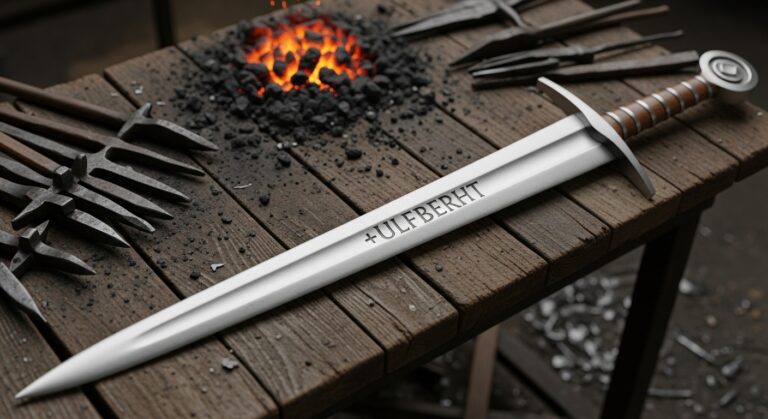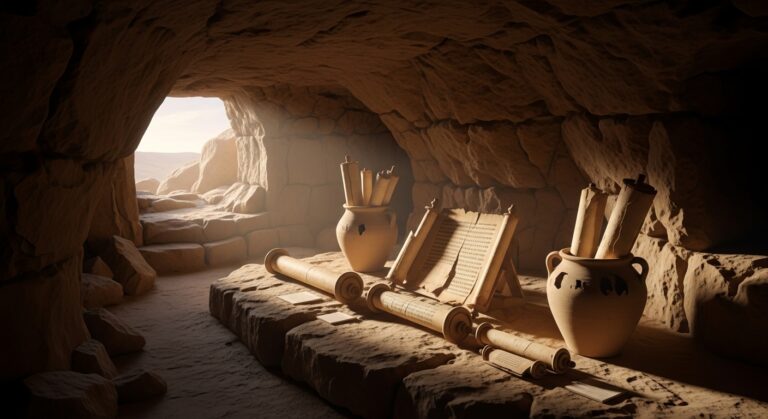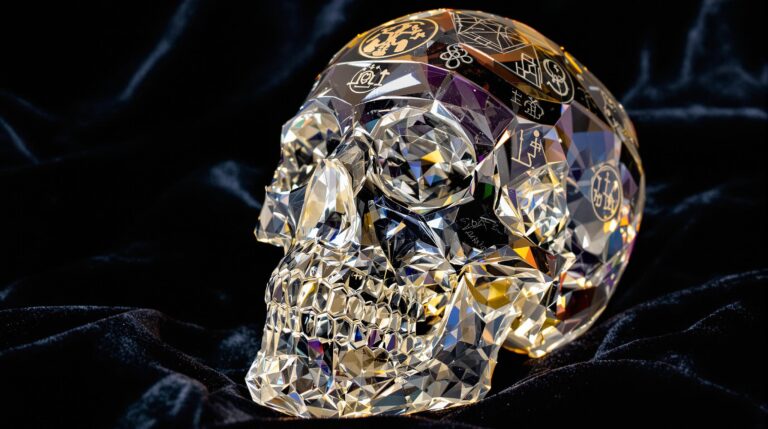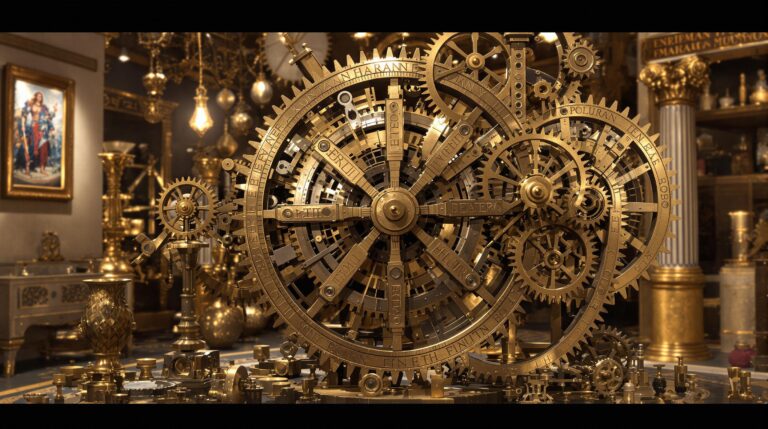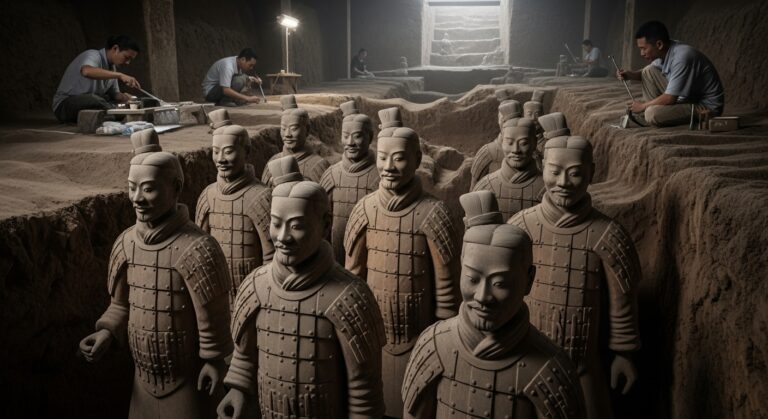The Jade Burial Suits of Ancient China
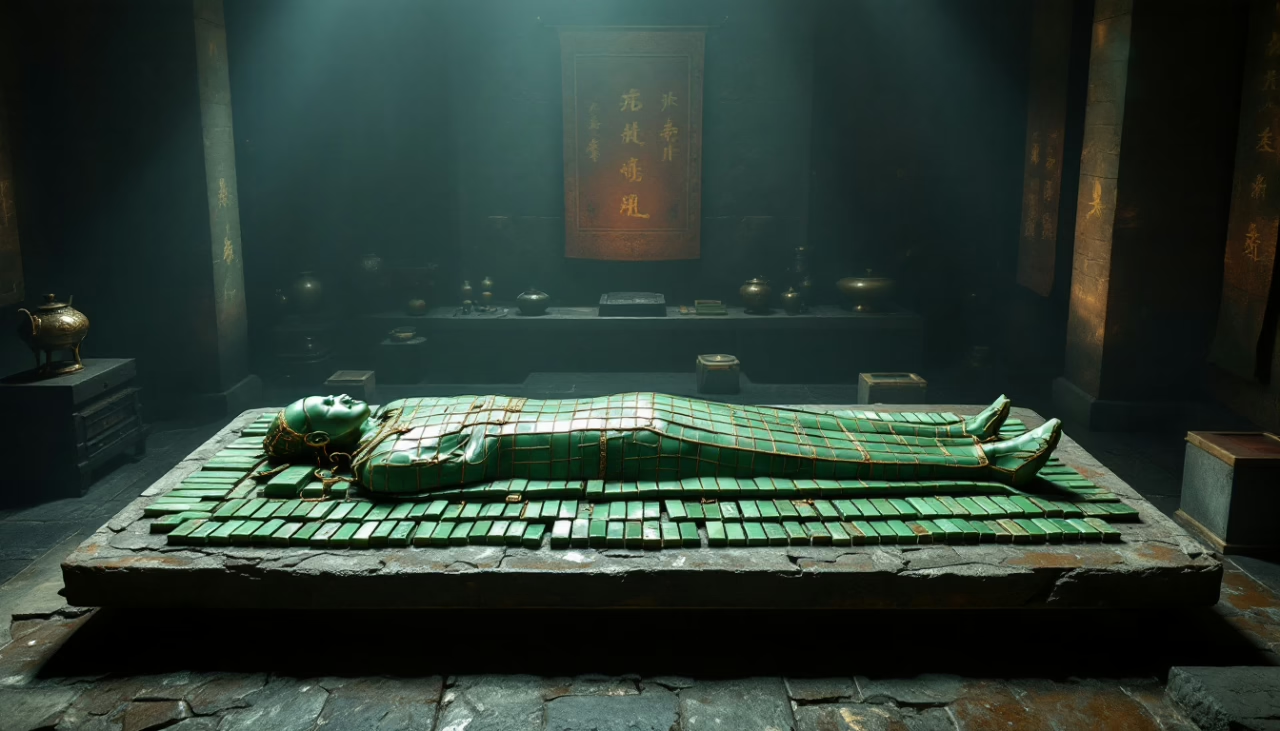
The Forgotten Art of Jade Burial Suits – In the shadowy tombs of Han Dynasty elites, jade burial suits stand as silent guardians between worlds.
These meticulous creations, comprised of thousands of polished jade pieces sewn together with gold or silver thread, represented the pinnacle of ancient Chinese funerary artistry.
Archaeologists marvel at their construction—each suit requiring decades of skilled craftsmanship—while scholars debate their spiritual efficacy.
Did these gleaming cocoons truly preserve imperial bodies for eternity, as ancient texts suggest, or merely symbolize the ultimate expression of status?
Summary & Key Takeaways
Hide- Jade burial suits were elaborate protective garments made from thousands of jade pieces sewn with gold, silver, or bronze wire for Chinese nobility.
- Constructed during the Han Dynasty, these suits reflected beliefs that jade preserved the body and facilitated passage to the afterlife.
- Materials used in stitching indicated social hierarchy—gold thread for emperors, silver for princes, and bronze for lesser nobles.
- Each suit required 2,000-2,400 jade plates and extensive craftsmanship, representing a significant investment in resources and labor.
- The practice declined after Emperor Wu's death due to imperial edicts, economic pressures, and Buddhism's growing influence.
Origins of Jade Burial Practices
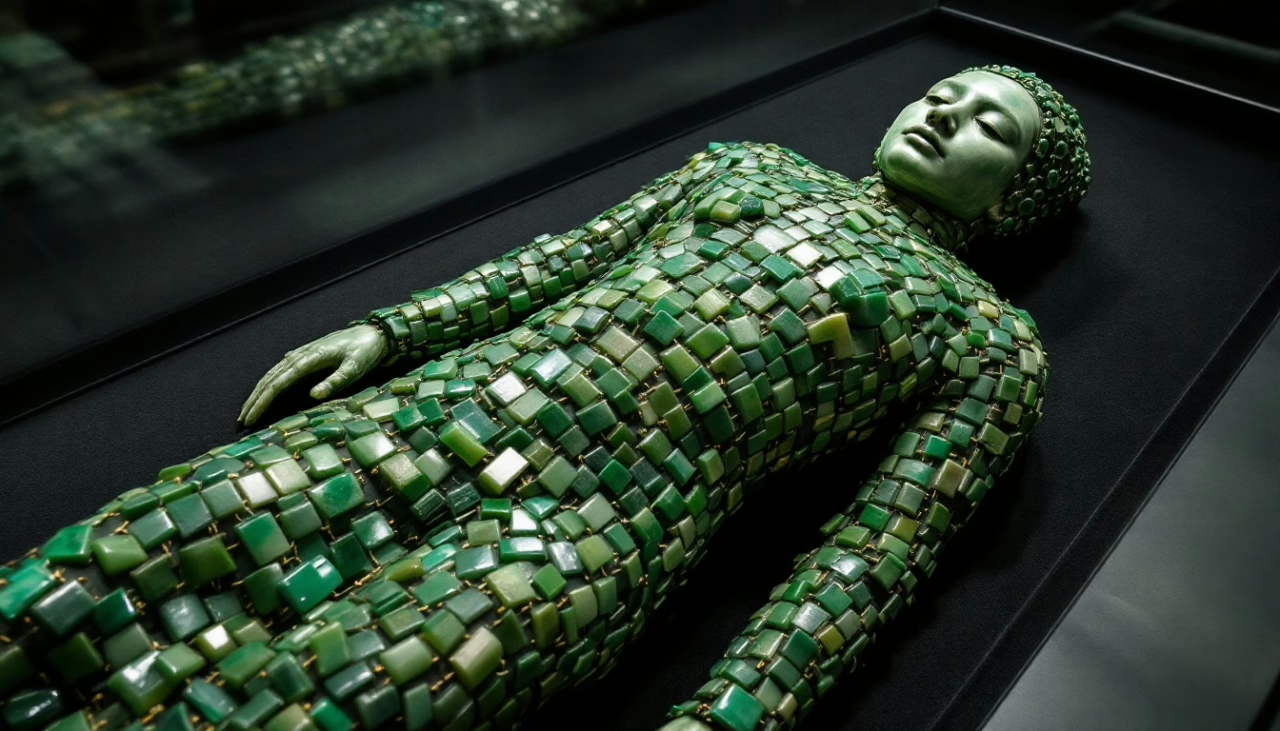
Jade, revered for its ethereal beauty and symbolic connection to immortality, became inextricably linked with burial practices in ancient China as early as the Neolithic period.
By the time of the Western Han Dynasty (206 BCE–9 CE), this sacred stone had evolved from simple burial accompaniments to elaborate protective suits, meticulously crafted from thousands of polished jade pieces sewn together with gold, silver, or bronze thread.
These remarkable burial garments, reserved exclusively for nobility and royalty, represented the culmination of centuries-old beliefs that jade could preserve the physical body and escort the soul safely into the afterlife.
Early Symbolism of Jade in Chinese Culture
Jade’s significance in early Chinese death rituals stemmed from its perceived ability to preserve the body and protect the soul during its journey to the afterlife, beliefs established centuries before the famous Han Dynasty burial suits emerged.
Archaeological evidence from Neolithic sites reveals jade bi discs, cong tubes, and small ornaments strategically placed on corpses’ essential points—eyes, mouth, and chest—suggesting an already sophisticated understanding of jade’s spiritual properties.
This ceremonial use evolved from earlier practices where jade adorned the living as symbols of status and spiritual connection, eventually transforming into the elaborate mortuary traditions that would reach their apex in the jade burial suits of imperial China.
Spiritual significance and protective qualities
Spirituality permeated ancient Chinese burial customs, particularly through the veneration of jade as a divine material believed to safeguard the body’s journey into the afterlife.
The stone’s cultural significance stemmed from its perceived ability to confer immortality concepts upon the deceased, forming an impenetrable barrier against decay.
These afterlife beliefs transformed jade symbolism into tangible spiritual protection, preserving aristocratic bodies for eternity through these remarkable suits.
Use of jade in pre-Han rituals and adornments
The genesis of China’s jade burial traditions extends far beyond the Han Dynasty, with archaeological evidence revealing sophisticated uses of the precious stone in funerary contexts dating back to the Neolithic period.
Excavations at sites like Lingjiatan and Hongshan have uncovered intricate jade adornments and ritual objects, demonstrating early jade symbolism and remarkable craftsmanship dedicated to jade preservation—a material believed to fortify the soul’s journey beyond death.
Rise of Jade Suits During the Han Dynasty
The Han Dynasty (206 BCE-220 CE) marked a pivotal turning point in the evolution of jade burial practices, as imperial decrees restricted complete jade burial suits exclusively to emperors and high-ranking nobles.
Legal codes meticulously outlined the number of jade pieces permitted for different ranks, with emperors’ suits containing over two thousand individually carved plaques connected with gold wire, while lesser nobles used silver or bronze threading.
These ornate jade ensembles emerged from elaborate court ceremonies that transformed the practical preservation of royal bodies into spectacular rituals of immortality, reflecting the dynasty’s belief that jade could prevent bodily decomposition and facilitate the soul’s journey through the afterlife.
Timeline and royal exclusivity
Dating back to China’s Western Han Dynasty (206 BCE–9 CE), jade burial suits emerged as extraordinary funerary innovations reserved exclusively for imperial family members and high nobility.
The dynastic hierarchy strictly regulated access to this elite craftsmanship, with royal exclusivity enforced through imperial edicts.
Jade symbolism in these elaborate burial practices reflected the aristocracy’s pursuit of immortality—a freedom from death’s constraints that commoners could scarcely imagine.
Legal and ceremonial context of jade usage
During Emperor Wu’s reign in the Western Han Dynasty, legal codification of jade burial practices emerged through a series of imperial edicts that fundamentally transformed funerary customs among China’s elite.
These regulations formalized the ceremonial rituals surrounding jade’s use in burial customs, elevating its cultural significance beyond mere decoration.
The legal implications of these edicts restricted certain jade symbolism exclusively to imperial family members, reinforcing social hierarchies even in death.
Construction and Craftsmanship
The jade burial suits of Han Dynasty elites represent remarkable achievements in ancient craftsmanship, comprising thousands of meticulously cut jade pieces arranged to form a complete body covering from head to toe.
Each suit required between 2,000 and 2,400 individual jade plates—rectangular for the body and limbs, circular for the head—meticulously crafted to fit together like an intricate mosaic of immortality.
These precious jade pieces were joined using gold, silver, or copper wire threading, with the material choice reflecting the deceased’s status: gold for emperors, silver for nobles, and copper for lesser aristocracy.
Anatomy of a Jade Burial Suit
The jade burial suits of Han Dynasty elites represented extraordinary feats of craftsmanship, typically comprising between 2,000 and 2,600 individual jade pieces meticulously cut and polished to form a complete body covering.
These rectangular or square jade plates, varying in size from larger pieces for the torso to smaller ones for extremities, were linked together using gold, silver, or bronze wire—the precious metal chosen according to the deceased’s social standing in a rigid hierarchy established by imperial decree.
Emperors and empresses were granted the privilege of gold wire, aristocrats received silver connections, while lesser nobles had to settle for bronze or copper threads, creating a visible manifestation of status that would accompany them into the afterlife.
Number of jade pieces and design structure
Astonishingly, each jade burial suit contained between 2,000 and 2,600 individual jade pieces, meticulously arranged to cover the deceased’s entire body in a glittering armor of immortality.
The jade craftsmanship techniques evolved to accommodate increasingly complex burial suit aesthetics, with variations reflecting:
- Social rank of the deceased
- Regional jade piece symbolism
- Available materials and resources
- Prevailing philosophical beliefs about mortality
Variations based on social status and rank
Intricate hierarchical distinctions permeated every aspect of jade burial suit production, transforming these funerary garments into tangible manifestations of social stratification within ancient Chinese society.
Elite interments revealed profound rank disparities through material quality and craftsmanship; emperors received pure jade bound with gold wire while lesser nobles endured silver or copper bindings.
Such burial customs reinforced jade significance as the ultimate expression of social hierarchy even in death.
The Threads That Held Them Together
The jade plates comprising burial suits were meticulously connected using threads of precious metals and textiles, with archaeological evidence revealing gold wire for emperors, silver for nobles, copper for officials, and silk for wealthy merchants.
These connecting materials, far from mere functional elements, served as powerful symbolic indicators of social position within Han Dynasty hierarchy, where even in death, one’s status remained visibly encoded through the very threads holding one’s burial garment together.
The painstaking process of threading thousands of jade pieces together demanded extraordinary craftsmanship, requiring artisans to drill precisely aligned holes through stone plates that were often no thicker than a modern credit card, a feat accomplished without the benefit of modern tools.
Materials used: gold, silver, copper, silk
Artisans of ancient China united four precious materials—gold, silver, copper, and silk—to create burial suits of extraordinary sophistication and symbolic power.
Each material carried profound significance in ancient Chinese cosmology:
- Gold threads represented immortality and celestial radiance
- Silver symbolized purity and lunar energy
- Copper connected to earth elements and ancestral origins
- Silk embodied transformation and cultural refinement
These material choices reflected both practical craftsmanship and metaphysical beliefs.
Hierarchy reflected in stitching choices
Social hierarchy in ancient China extended even into death, manifesting distinctly in the stitching techniques employed for jade burial suits.
The elite received gold thread stitching, a luminous status symbol requiring specialized craft masters, while silver and copper bindings designated lesser nobility.
These artistic expressions of social stratification transformed practical construction decisions into political statements, with each thread reinforcing the deceased’s place in cosmic order.
Notable Discoveries and Archaeological Finds
The 1968 excavation of Mancheng tomb yielded archaeology’s most spectacular jade burial suits: Prince Liu Sheng‘s ensemble, comprising 2,498 jade plates joined with gold wire, and Princess Dou Wan’s companion piece featuring slightly smaller plates but equally intricate craftsmanship.
These Han Dynasty royal burial garments, constructed during the 2nd century BCE, represented not only the pinnacle of mortuary extravagance but also confirmed historical records that had previously been dismissed as mere hyperbole.
Their remarkable preservation allows modern scholars to examine both the technical virtuosity of ancient Chinese artisans and the profound metaphysical beliefs that connected jade to immortality in the royal cosmology.
Prince Liu Sheng’s Jade Suit
The discovery of Prince Liu Sheng’s jade burial suit in the Mancheng tombs represents one of archaeology’s most significant finds, revealing unprecedented insight into Han Dynasty funerary practices.
Consisting of over 2,498 jade plates meticulously sewn together with gold wire, the suit exemplifies the extraordinary craftsmanship and resources devoted to royal burials in ancient China.
Its remarkable state of preservation allows scholars to examine not only the technical sophistication of Han Dynasty artisans but also the complex spiritual beliefs that compelled rulers to commission such elaborate protection for their journey into the afterlife.
Discovery in the Mancheng tombs
Perhaps the most extraordinary archaeological discovery of the twentieth century occurred in 1968, when Chinese archaeologists unearthed the immaculately preserved tomb of Prince Liu Sheng and his consort Dou Wan at Mancheng, Hebei Province.
The excavation yielded unprecedented insights into Han burial customs through:
- Over 2,800 jade pieces meticulously sewn together
- Revolutionary excavation techniques preserving fragile artifacts
- Elaborate burial chamber architecture revealing social hierarchies
- Accompanying treasures documenting elite material culture
Significance of the suit’s preservation and detail
Preservation itself, in all its remarkable wonder, seldom reveals ancient craftsmanship with such extraordinary clarity as found in Prince Liu Sheng’s jade suit, where each meticulously connected piece offers unprecedented insight into Han Dynasty funerary practices.
The suit’s flawless condition illuminates both preservation techniques and cultural legacy, providing modern interpretations of aesthetic value within proper historical context—a demonstration of imperial China’s sophisticated mortuary traditions.
Princess Dou Wan’s Burial Ensemble
Princess Dou Wan’s jade burial ensemble, discovered in 1968 alongside her husband Liu Sheng’s, exhibits several distinctive characteristics that set it apart from her royal spouse’s suit.
While maintaining the same basic structure of jade pieces linked with gold wire, her suit features more delicate craftsmanship and slightly smaller proportions, reflecting the gender distinctions observed in Han Dynasty burial customs.
Archaeological analysis reveals her ensemble incorporated a higher percentage of white jade and contained additional ornamental elements, including an elaborate headdress and jade-inlaid accessories that suggest her elevated status within the imperial hierarchy.
Comparison with Liu Sheng’s suit
Two distinct jade burial suits emerged from the excavation of Mancheng tomb #2, with Princess Dou Wan’s ensemble revealing significant differences when compared to her husband Liu Sheng’s more elaborate garment.
The key differences include:
- Thread material – silver for Dou Wan versus gold for Liu Sheng
- Jade count – 2,160 plates versus Liu’s 2,498
- Craftsmanship quality – slightly less refined
- Fewer decorative elements reflecting Han dynasty immortality beliefs
Unique features in style and materials used
The extraordinary jade suit of Princess Dou Wan, uncovered in 1968 by archaeologists with careful reverence, stands as a symbol of Han dynasty craftsmanship while embodying several distinctive features that set it apart from other burial garments of the period.
Its jade sourcing reflects regional variations, incorporating stones of varied hues that amplify color symbolism within Dou Wan’s burial suit styles, revealing sophisticated jade craftsmanship unmatched in contemporary royal interments.
Cultural and Spiritual Beliefs Behind the Suits
At the heart of jade burial suit creation lay the Han dynasty‘s fervent pursuit of immortality, a quest manifested through elaborate funerary practices designed to preserve the body eternally.
Jade, considered the essence of cosmic qi energy, was believed to prevent decomposition by sealing the body from malevolent spirits that might disturb the deceased’s journey to the afterlife.
Tomb texts and symbolic inscriptions adorning these suits reveal an intricate spiritual dimension, where the deceased, encased in their jade armor, could navigate the treacherous spiritual domain and achieve the immortal existence so desperately sought by emperors and nobility alike.
Pursuit of Immortality in Han Thought
In the shadowed chambers of Han dynasty tombs, jade served not merely as decoration but as the physical manifestation of immortality itself, believed to preserve the body from decay while anchoring the spirit to its earthly vessel.
The luminous green stone, cool to the touch yet somehow alive with inner light, embodied the quintessential Daoist principle of incorruptibility, its molecular structure so stable that ancient Chinese philosophers considered it the perfect medium for extending human existence beyond death.
These elaborate burial suits, with thousands of jade plates meticulously sewn together with gold, silver, or silk thread, represented the culmination of Daoist alchemical thought—a transformation of the noble deceased into immortal beings who might traverse the boundaries between the mortal world and the celestial domains of the immortals.
Role of jade in preserving the body and spirit
Central to Han Dynasty cosmology, jade was believed to possess supernatural qualities that could preserve a noble’s body and spirit throughout eternity.
The immortality pursuit manifested through jade’s powerful body preservation properties.
Ancient texts reveal four essential spiritual beliefs about jade symbolism:
- Jade prevents bodily decay
- It preserves spiritual essence
- It wards off evil entities
- It facilitates passage to immortal domains
Influence of Daoist ideas on burial rituals
While Confucian doctrines dominated Han society’s political structure, Daoist philosophies profoundly shaped funerary practices and the spiritual conceptualization of the afterlife, particularly evident in the creation of jade burial suits.
Ritual purification through jade aligned with Daoist cosmology, transforming ancestral worship into a quest for spiritual transcendence.
These immortality beliefs represented liberation from corporeal constraints, offering the deceased freedom through cosmic reintegration.
Tomb Texts and Symbolic Inscriptions
The jade burial suits of Han China featured intricate inscriptions and accompanying texts that promised supernatural protection in the afterlife, transforming these garments into powerful talismans against decay and spiritual harm.
Ancient craftsmen meticulously etched auspicious symbols and characters onto jade pieces, believing these mystical inscriptions would activate jade’s inherent powers to preserve the body and guide the soul through its postmortem journey.
Beyond mere decoration, these symbolic engravings represented a sophisticated cosmological language, connecting the deceased to celestial forces through jade’s perceived ability to conduct qi energy between dimensions.
This belief was documented in numerous tomb manuscripts that outlined proper funerary protocols for the elite.
Associated scripts and talismans
Inscribed with mystical scripts and adorned with protective talismans, jade burial suits represented not merely physical containers but spiritually charged vessels meant to safeguard the deceased in their afterlife journey.
The ritualistic inscriptions incorporated symbolic language that served multiple functions:
- Warding off malevolent spirits
- Ensuring immortality through precise symbolic formulations
- Mapping the celestial journey for the departed soul
- Establishing hierarchical status in the afterlife domain
Mystical beliefs tied to jade’s properties
Ancient Chinese cosmology regarded jade as fundamentally sacred, possessing metaphysical properties that transcended ordinary matter—a belief system that informed every aspect of burial suit creation.
Beyond mere aesthetics, jade symbolism encompassed immortality through its perceived ability to prevent bodily decay.
These mystical properties reflected cultural beliefs that jade served as a spiritual conduit between spheres, ancient practices suggesting its protective qualities extended beyond death into otherworldly transformations.
Decline and Rediscovery
The practice of creating jade burial suits gradually disappeared following Emperor Wu’s death in 141 BCE, when imperial edicts banned the extravagant funerary practice to stem corruption and conserve resources.
These magnificent suits, symbols of a lost tradition, remained buried in obscurity for centuries until archaeological excavations in the 20th century revealed their breathtaking craftsmanship to a modern world.
Today, several complete jade burial suits stand as centerpieces in major museums across China and internationally, offering silent testimony to the ancient Chinese belief in jade’s power to preserve the body and soul for eternity.
Why the Practice Faded Away
The meticulous practice of creating jade burial suits gradually waned following the Eastern Han Dynasty, as new rulers implemented sweeping reforms to burial customs and sought to curtail what they viewed as excessive funerary expenditures.
Philosophical transformations, particularly the rising influence of Buddhism with its emphasis on impermanence and the illusory nature of material possessions, challenged the traditional Confucian and Daoist notions that had supported elaborate jade encasements for the deceased.
These cultural and ideological shifts, coupled with the astronomical costs of producing such intricate burial garments, rendered the jade suits increasingly rare until they faded into historical obscurity, only to be rediscovered by archaeologists in modern times.
Shifts in dynastic rule and burial customs
Despite their remarkable craftsmanship and cultural significance, jade burial suits gradually faded from Chinese funerary traditions as dynastic power shifted and societal values evolved.
Several factors contributed to this cultural shift:
- Tang Dynasty’s prohibition of lavish burials
- Rising Confucian values emphasizing simplicity
- Economic pressures during dynastic changes
- Buddhist cremation practices gaining prominence
These ritual adaptations reflected broader political influences reshaping burial evolution.
Changing philosophical views on death
Philosophical undercurrents throughout ancient China gradually transformed attitudes toward mortality and posthumous preservation, reshaping funerary practices more profoundly than material constraints alone.
Buddhist influences introduced cremation, while Confucian ideals emphasized modest burial rituals that honored ancestral worship without extravagance.
Simultaneously, evolving Taoist beliefs regarding immortality redirected focus from material preservation to spiritual transcendence, reflecting broader societal changes in how the elite conceptualized the afterlife.
Modern Rediscovery and Museum Exhibits
The modern rediscovery of jade burial suits began in earnest during the 1950s, when archaeological teams unearthed Prince Liu Sheng and Princess Dou Wan’s extraordinary jade suits at Mancheng, catapulting these ancient treasures into international prominence.
Museums worldwide, from Beijing’s National Museum of China to the British Museum, now showcase these intricate creations behind specially designed glass enclosures that maintain precise humidity and temperature controls, preserving their delicate jade plates and gold threading.
Conservation specialists face ongoing challenges in maintaining these fragile artifacts, which, having survived two millennia underground, now contend with air pollution, vibration damage, and the constant scrutiny of fascinated visitors who stand transfixed before these glittering windows into ancient Chinese aristocratic afterlife preparations.
Timeline of excavations and public interest
Although archaeological interest in jade burial suits waned during China’s tumultuous political periods of the early 20th century, their rediscovery in 1968 marked a pivotal moment in our understanding of Han dynasty funerary practices.
Public sentiment evolved dramatically, as evidenced by:
- 1968 – Initial excavation methods uncovered Dou Wan’s suit
- 1973 – Cultural preservation efforts formalized
- 1984 – Rise of ancient tourism at excavation sites
- 2000s – Archaeological significance internationally recognized
Conservation efforts and display challenges
Nearly every jade burial suit now displayed in museums across China presents unique conservation challenges stemming from their millennia-long entombment and subsequent excavation.
Museum curators employ specialized conservation techniques to stabilize these fragile artifacts, balancing display aesthetics with preservation imperatives.
The suits’ thousands of jade plates, once bound with gold or silver wire, require meticulous restoration to engage public interest while maintaining archaeological integrity.
Ongoing Questions and Interpretations
Despite decades of archaeological study, scholars continue to question the true efficacy of jade burial suits in preserving imperial bodies, with some suggesting their function was purely symbolic rather than practical.
The discovery of several unfinished and fragmented suits presents an additional enigma, challenging researchers to determine whether these represent interrupted craftsmanship, deliberate ritual variations, or evidence of tomb robbery.
These persistent mysteries illuminate the complex intersection between ancient Chinese funerary practices, material culture, and cosmological beliefs, inviting contemporary interpretations that extend beyond archaeological evidence into domains of cultural meaning and spiritual significance.
Debate on Effectiveness of Jade in Preservation
Despite ancient Chinese beliefs in jade’s mystical preservative powers, modern scientific analysis reveals a more complex picture, with excavated jade-suited bodies showing varying degrees of preservation rather than the miraculous conservation promised in historical texts.
Archaeological findings from tombs like that of Liu Sheng and Dou Wan present contradictory evidence: while some jade-encased remains showed remarkable preservation, others deteriorated considerably, suggesting environmental factors and burial techniques may have played more vital roles than the jade itself.
This tension between cultural narratives and scientific evidence continues to fuel scholarly debate about whether jade burial suits served primarily symbolic, spiritual functions or if the mineral indeed possessed properties that, under specific conditions, contributed to corporeal preservation.
Scientific findings vs. cultural beliefs
Scholars frequently debate the efficacy of jade as a preservative in Han Dynasty burial suits, weighing scientific evidence against deeply entrenched cultural beliefs.
Modern scientific analysis reveals:
- Jade contains no inherent antimicrobial properties
- Environmental factors supersede material composition in preservation
- Cultural significance often trumped actual preservation techniques
- Jade symbolism represented immortality despite physical decomposition
The archaeological record challenges ancient assumptions while honoring jade’s ceremonial importance.
Evidence from excavation results
Archaeological excavations of jade burial suits have yielded complex, often contradictory evidence regarding their effectiveness as preservative measures.
Modern burial site analysis reveals varying states of preservation, suggesting factors beyond jade itself—including excavation techniques, cultural context, and environmental conditions—significantly impact artifact preservation.
Archaeological methods continue to evolve, allowing researchers to extract more nuanced data from these magnificent, enigmatic treasures of ancient Chinese nobility.
The Mystery of Unfinished or Fragmented Suits
Archaeological discoveries of incomplete jade burial suits present a compelling enigma for scholars of Han Dynasty funerary practices, suggesting possibilities ranging from economic constraints to deliberately symbolic partial entombments.
The fragments—some missing hundreds of pieces while others lack only small sections—may reflect dramatic shifts in political fortune, as families of the deceased potentially lost favor or resources before completion of these labor-intensive works.
Each unfinished masterpiece tells a poignant story of interrupted ritual, inviting us to reflect on how ancient Chinese death practices navigated the unpredictable terrain between ideal ceremony and practical reality.
Possible reasons for incomplete suits
Despite the meticulous craftsmanship and immense cultural value attributed to jade burial suits, researchers continue to encounter mysterious instances where these funerary garments appear incomplete or fragmented, challenging conventional understanding of ancient Chinese burial practices.
Scholars propose several explanations for this phenomenon:
- Ritual interruption due to political upheaval
- Symbolic partial completion reflecting social status
- Resource limitations affecting jade craftsmanship
- Intentional historical modification of burial practices
Insights into interrupted or altered burials
Recent excavations of Han dynasty tombs have disclosed a perplexing paradox within jade burial suit assemblages, revealing patterns of interruption that speak volumes about ancient mortuary circumstances.
These interrupted rituals suggest complex burial practices during periods of cultural shifts and dynastic upheaval, where historical contexts—including political instability, resource scarcity, or invading forces—directly impacted archaeological records, leaving behind fragmented legacies rather than completed ceremonial intentions.
Wrapping Up
The jade burial suits remain among ancient China’s most remarkable funerary innovations, embodying the intersection of artistic mastery, spiritual devotion, and imperial privilege.
What other civilization has so literally armored its elite against death itself?
Though their practical efficacy in preserving bodies proved illusory, these dazzling creations endure as symbols of humanity’s eternal quest to transcend mortality through beauty, craftsmanship, and the transformative power of belief.
